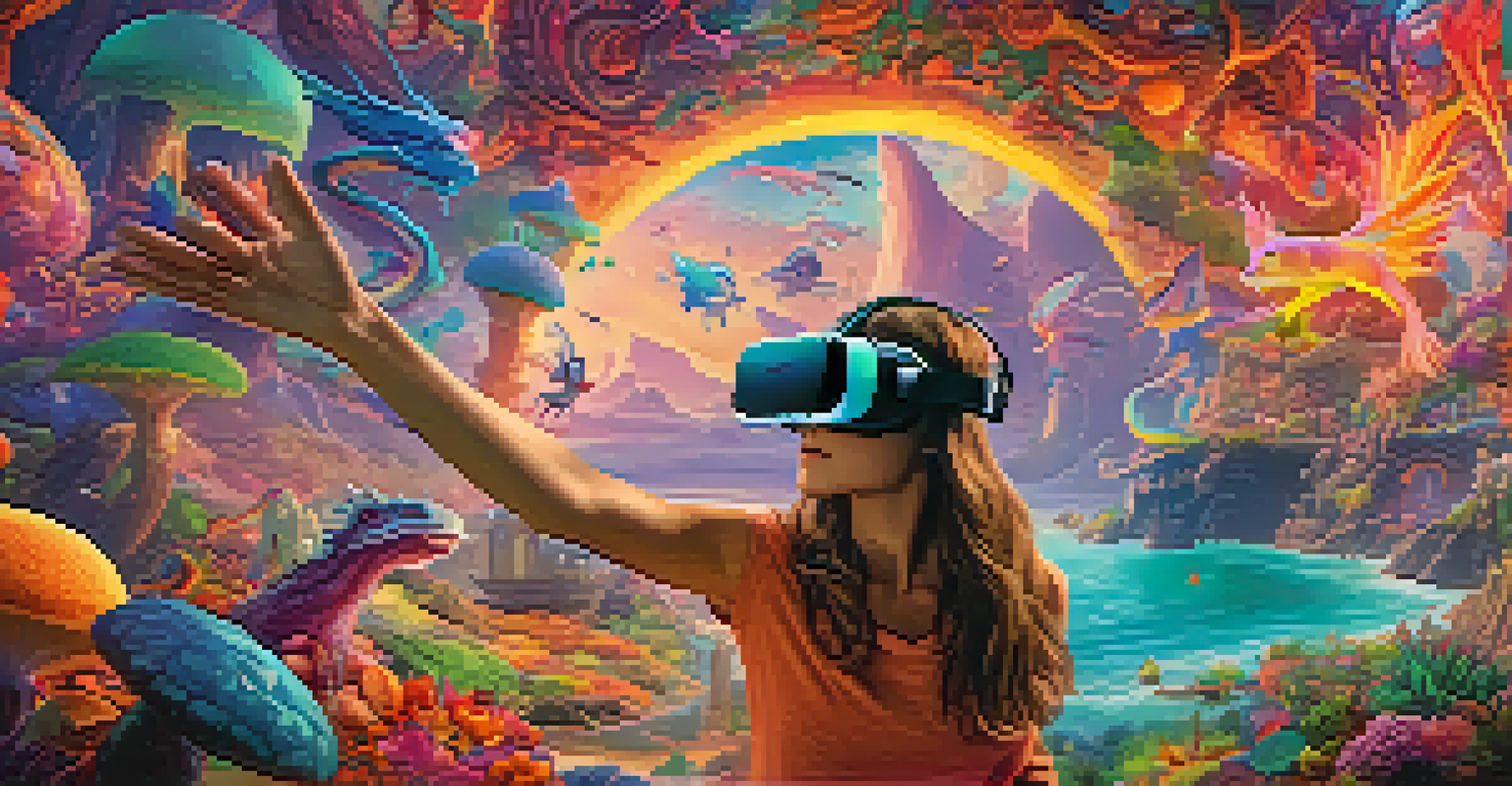Creating Immersive Soundscapes with 3D Audio Technology

Understanding 3D Audio Technology Basics
3D audio technology is a fascinating innovation that allows sound to be experienced in a three-dimensional space. Unlike traditional stereo sound, which is limited to left and right channels, 3D audio adds depth, height, and presence, making audio feel more immersive. Imagine being in a concert where you can hear the music not just from the front but also from above and around you, as if you were right in the middle of the action.
The ear is the avenue to the heart.
This technology uses advanced algorithms and spatial audio techniques to replicate how we naturally perceive sound. Our ears pick up not just the intensity of sounds but also their direction and distance, and 3D audio aims to mimic this experience. By placing sounds in a virtual environment, it creates a more realistic auditory experience that can transport listeners into entirely new worlds.
As 3D audio continues to evolve, its applications are expanding beyond just music and movies. From video games to virtual reality environments, the ability to create a rich soundscape enhances the overall experience and can even influence emotions and reactions. Understanding the basics of 3D audio sets the stage for exploring its creative possibilities.
The Science Behind 3D Sound Perception
The way we perceive sound is deeply rooted in science, specifically in how our ears and brain work together. When a sound is produced, it travels through the air and reaches our ears at slightly different times and intensities, allowing us to pinpoint its location. This phenomenon is the basis for binaural audio, which is a key component of 3D sound technology.

To create an immersive sound experience, audio engineers use techniques like binaural recording, which involves capturing sound using two microphones placed in a way that simulates human ears. This method helps to replicate the natural listening experience, resulting in audio that feels as if it’s happening all around us. When played back through headphones, it tricks the brain into perceiving spatial sound, enhancing the feeling of immersion.
3D Audio Enhances Immersive Experiences
3D audio technology creates a richer, more immersive sound environment, allowing listeners to feel as if they are part of the action in music, movies, and games.
Moreover, 3D audio technology also incorporates elements like sound reflection and diffusion, which mimic how sound interacts with the environment. Just like how echoes bounce off walls and other surfaces, these factors contribute to the realism of soundscapes. By understanding the science behind sound perception, creators can craft experiences that resonate with audiences on a deeper level.
Applications of 3D Audio in Entertainment
One of the most exciting applications of 3D audio technology is in the entertainment industry, particularly in movies and video games. Filmmakers are increasingly using spatial audio to create soundscapes that envelop viewers, making them feel as if they are part of the story. Imagine watching an action movie where explosions and dialogue come from all directions, enhancing the thrill and excitement.
Sound is the vocabulary of nature.
In the realm of gaming, 3D audio plays a crucial role in creating realistic environments and enhancing gameplay. Players can hear footsteps approaching from behind or the rustle of leaves indicating nearby movement, adding to the immersion. This heightened sense of awareness can significantly impact a player's strategy and overall experience, making them feel more engaged in the virtual world.
Moreover, as streaming platforms adopt 3D audio formats, audiences can enjoy a more cinematic experience at home. Services like Dolby Atmos are leading the charge, giving viewers access to content that utilizes this technology. With 3D audio becoming more prevalent, it’s clear that the future of entertainment will be shaped by how sound can transform storytelling.
Enhancing Virtual Reality with 3D Audio
Virtual reality (VR) is another realm where 3D audio technology shines, creating a more immersive and believable experience. In VR, visuals are only part of the equation; sound plays a critical role in making users feel present in a simulated environment. When users can hear sounds as if they are coming from specific directions, it enhances the realism of the experience.
For example, in a VR game, the sound of an approaching enemy can trigger a response, guiding players to react in real time. This interplay between sound and action is what makes VR so engaging. The more accurately sound mimics reality, the more users can immerse themselves in the experience, whether they're exploring a fantastical world or participating in a training simulation.
Applications Expand Beyond Entertainment
Beyond entertainment, 3D audio is being integrated into virtual reality and education, enhancing realism and engagement across various fields.
As the technology continues to advance, developers are finding new ways to integrate 3D audio into VR experiences. From interactive storytelling to educational simulations, the potential applications are vast. By enhancing virtual reality with sound, creators can develop experiences that not only entertain but also educate and inspire.
The Role of 3D Audio in Gaming
Gaming has always been at the forefront of technological innovation, and 3D audio is no exception. As players dive into immersive worlds, the ability to hear sound in three dimensions adds a new layer of depth to gameplay. This technology allows players to detect sounds from various directions, making it easier to navigate complex environments and react to in-game events.
For instance, in a first-person shooter, the sound of gunfire can indicate the position of an enemy, while the distant roar of a vehicle might suggest impending danger. This auditory feedback not only enhances the gaming experience but also influences strategy and decision-making. Players become more attuned to their surroundings, fostering a more engaging and interactive experience.
With advancements in audio technology, gaming companies are continuously experimenting with new ways to incorporate 3D audio into their titles. As these experiences become more sophisticated, players can expect to be enveloped in soundscapes that are as rich and dynamic as the visual elements of the game. Ultimately, 3D audio is reshaping the future of gaming.
Creating 3D Soundscapes for Music
3D audio technology is revolutionizing the way we experience music, transforming traditional listening into an immersive journey. Artists and producers are now able to craft soundscapes that envelop listeners, creating a feeling of being surrounded by music. This approach moves beyond stereo mixing, allowing for creative possibilities that enhance the emotional impact of a song.
For example, a live concert recording can be transformed into a 3D audio experience where listeners feel as if they are in the front row, with instruments surrounding them. This immersive quality not only elevates the listening experience but also brings listeners closer to the artist's vision. The result is a unique musical journey that resonates on a deeper emotional level.
Future Trends in 3D Audio Technology
The future of 3D audio includes advancements in AI and sound design, promising even more personalized and immersive auditory experiences.
As streaming services adopt 3D audio formats, listeners can enjoy this innovative approach from the comfort of their homes. Whether it's a meditation playlist or an upbeat dance track, the spatial richness of sound can enhance enjoyment and engagement. As artists explore this technology, we can expect to see even more creative and immersive musical experiences.
Future Trends in 3D Audio Technology
As technology continues to evolve, the future of 3D audio looks promising and full of potential. Innovations in hardware and software are paving the way for even more immersive experiences, allowing creators to push the boundaries of sound design. From advancements in headphones to sophisticated audio processing algorithms, the possibilities are endless.
One exciting trend is the integration of artificial intelligence in audio production. AI can analyze sound patterns and help creators design more complex and nuanced soundscapes. This fusion of technology and creativity holds the promise of delivering experiences that are not only immersive but also personalized to individual preferences.

As we move forward, we can expect to see 3D audio becoming a standard in various industries, including entertainment, education, and healthcare. Whether it's enhancing a film, enriching a video game, or supporting therapy through sound, the impact of 3D audio technology will only grow. The future is bright for those who embrace the art and science of immersive sound.